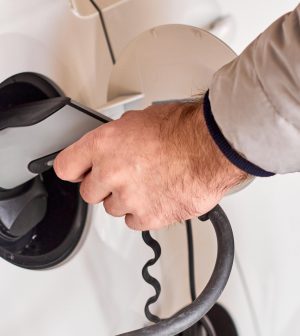- Skip Storing This Everyday Product in the Fridge Door
- Green Tea + B3 Pairing May Boost Brain Health
- Navigating Your Midlife Crisis: Embracing New Possibilities
- City Raccoons Showing Signs of Domestication
- Mapping the Exposome: Science Broadens Focus to Environmental Disease Triggers
- One Week Less on Social Media Linked to Better Mental Health
- Your Brain Changes in Stages as You Age, Study Finds
- Some Suicide Victims Show No Typical Warning Signs, Study Finds
- ByHeart Formula Faces Lawsuits After Babies Sickened With Botulism
- Switch to Vegan Diet Could Cut Your Greenhouse Gas Emissions in Half
Advent of Electric Cars Is Already Improving Health

Electric cars are still in the minority on America’s roads, yet researchers are already seeing health benefits from reduced tailpipe pollution.
In a new California study, neighborhoods with the most all-electric cars — called zero-emission vehicles — saw a decline in asthma-related emergency room visits. Researchers believe this was a result of lower levels of nitrogen dioxide (NO2) in the air.
“Results from this study provide some of the first real-world evidence suggesting that switching to zero-emissions vehicles could be a win-win, both reducing emissions of greenhouse gases and potentially improving local air quality and health,” said study co-author Sandrah Eckel, an associate professor of population and public health sciences at the University of Southern California’s Keck School of Medicine in Los Angeles.
The adoption of electric cars, however, was seen in areas with higher incomes and educational levels, she said. This might be due to their higher cost and the lack of charging facilities in rental properties.
“We are concerned about environmental justice because the communities that stand to benefit the most from reductions in air pollution and asthma ER visits are the communities at risk of being left behind in the transition to electric,” Eckel said.
“We need to overcome some of these barriers and make sure that the policies that are made can target the populations that stand to benefit the most from these environmental and health care benefits,” she added.
Eckel and her colleagues used data from the California Department of Motor Vehicles to look at electric automobile purchases by zip code and data from the U.S. Environmental Protection Agency to analyze NO2 levels. They also tracked emergency room visits for asthma between 2013 and 2019. Asthma, a respiratory disorder, has long been associated with air pollutants such as NO2.
At the zip code level, for every additional 20 electric or zero-emissions vehicles per 1,000 people, researchers saw a 3.2% drop in the rate of asthma-related ER visits.
As more electric cars and trucks inhabit the nation’s roads, Eckel believes the health benefits will continue to grow. She noted that all cars and light trucks sold by 2035 must be zero-emission vehicles in California.
“It was remarkable that we are already seeing health and possibly air quality improvements related to increasing numbers of zero-emission vehicles, even though zero-emission adoption levels are still low,” Eckel said.
As of last fall, nearly 18% of new cars sold in California were all-electric, according to California’s Office of the Governor. That compares with about 6% throughout the nation.
Will Barrett, senior director for clean air advocacy at the American Lung Association, was impressed by the study findings.
“That study really underscores that we will continue to see that by eliminating transportation pollution at the tailpipe you could have a real benefit in community health,” said Barrett, who wasn’t involved with the study.
“By transitioning to zero-emission technologies, we could be looking at over a trillion dollars in public health benefits across the United States over the coming decades,” he added.
The potential health benefits are considerable, Barrett said.
“We’re talking about reductions in asthma attacks, reductions in heart attacks and strokes, reductions in premature deaths and lung cancer,” he noted. “And also millions of lost workdays could be avoided by making the transition away from combustion to zero-emission.”
Barrett agreed that zero-emission vehicles need to be within the reach of all Americans. “Those in all communities, whether they’re rural or low-income — making sure that this distribution of health benefits is equitable across communities,” he said.
As the nation moves toward zero-emission heavy-duty trucks and buses, you can expect to see even more air and health improvements, Barrett said.
“The benefits of that transition are going to be even leaps and bounds greater in some ways than the passenger vehicle fleet benefits, because, for example, about 5% to 10% of all the vehicles on the road in the United States are medium and heavy-duty trucks, but they produce the most pollution of anything else on the road,” he explained.
“The transition to zero-emission trucking is going to be one of the most important public health interventions that we could see,” Barrett said.
The report was published Feb. 2 in the journal Science of the Total Environment.
More information
For more on car pollution, head to the Union of Concerned Scientists.
SOURCES: Sandrah Eckel, PhD, associate professor, population and public health sciences, Keck School of Medicine, University of Southern California, Los Angeles; Will Barrett, senior director, advocacy, clean air, American Lung Association; Science of the Total Environment, Feb. 2, 2023
Source: HealthDay
Copyright © 2025 HealthDay. All rights reserved.










